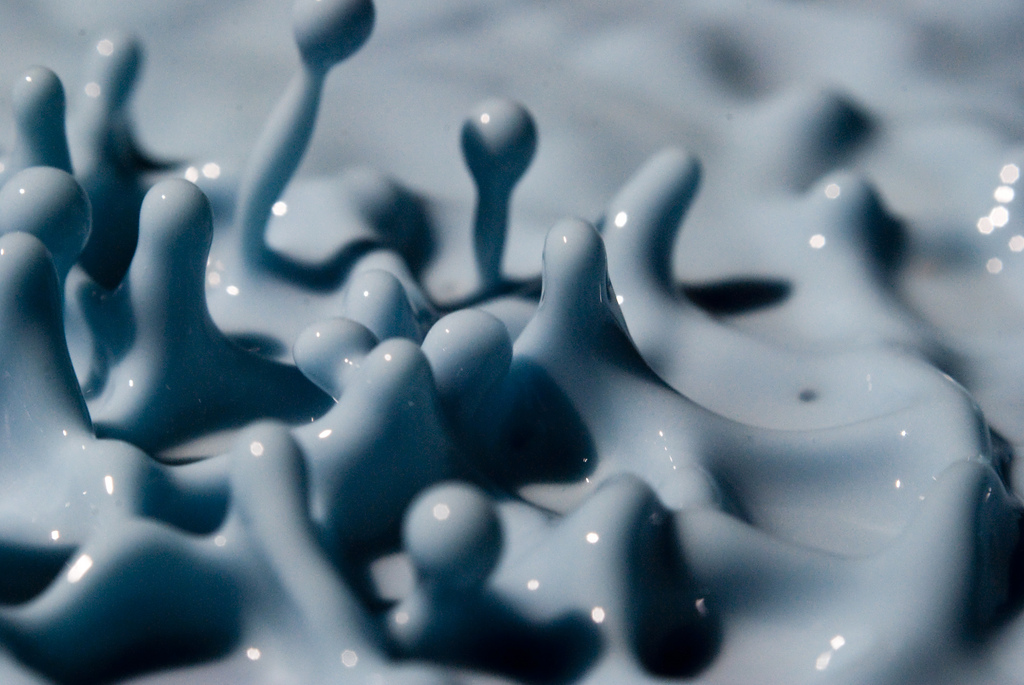What is a Non-Newtonian Fluid?
A non-Newtonian fluid is a fluid whose viscosity is variable based on applied stress, or force. Contrast with Newtonian fluids like water, whose behavior can be described exclusively by temperature and pressure (water at -32F/0C turned into ice, or water can be heated over it’s boiling point under high temperature), not the forces acting on it from second to second. Non-Newtonian fluids are fascinating substances that can be used to help us understand physics in more detail, in an exciting, hands-on way.
If you punch a bucket full of a shear thickening non-Newtonian fluid, the stress introduced by the incoming force causes the atoms in the fluid to rearrange such that it behaves like a solid. Your hand will not go through.
If you shove your hand into the fluid slowly, however, it will penetrate successfully. If you pull your hand out abruptly, it will again behave like a solid, and you can literally pull a bucket of the fluid out of its container in this way. You can try and walk on a non-Newtonian fluid if you stomp as best as you could on the surface.
A shear thinning non-Newtonian fluid behaves in the opposite way; where the application of force will make the solution act more as a liquid. In this type, the fluid becomes thinner, rather than thicker, when stress is applied. Also called pseudoplastic, examples of this type of non-Newtonian fluid include ketchup, toothpaste, and paint. The effect doesn’t usually last for long in either type, continuing only as long as the stress is applied. A good example is shaking the shaving cream can so the cream can be released from the can.
A practical application for shear thickening non-Newtonian fluids may be in body armor of the future. Since such fluids are usually flexible, they would allow soldiers to move freely when not under attack. But if confronted with a speeding bullet, they would quickly harder, performing like traditional armor. More research is necessary to see if non-Newtonian fluids are suitable for the military, but until then, it’s sure fun to play with.
The Experiment
Summary
Mix corn starch and water to create a non-Newtonian fluid. When left alone it will act like a liquid but when acted upon by a force it will react like a solid. If you hold it in your hand it will run through your fingers but if you punch the fluid it will harden
What you need:
- Corn Starch (About as much water as you are using)
- Water
- Containers
- Stirring rod (or anything to stir with)
- Ice
- Freezer
- Microwave
Steps
Put water in a big bowl/container you adding corn starch until the water becomes extremely tough to stir. It has also been described as a syrupy texture, but you should be able to feel a difference. If you are not sure, you can test it by applying pressure with the poke of your finger or a spoon. You will feel and initial resistance by the fluid and then it will slowly release.
Experiment 1: Texture is Dependent on Ingredient
You will notice if you leave the fluid unattended for a spell, it will separate into two parts and solid will be on the bottom of the container. Simply mix it up once again to regain the non-Newtonian fluid texture.
As you poke and prod at the mixture, you can see and feel (if you use your hands) the mixture turning solid into liquid or vice versa. Get hands on! The texture is great to feel and will keep you occupied for hours on end!
After messing around for a bit, add more corn starch. This results in a more solidified liquid and you can better feel the reactions.
Experiment 2: Heat and non-Newtonian Fluid
The first additional experiment that was tested was by microwaving part of the fluid. I put it in the microwave for roughly 45 seconds on half power (5, in my case). This resulted in what looked like an egg-shaped object, with a yellow center and a white outer ring.
Experiment 3: Cold Temperature and non-Newtonian Fluid
In this experiment, I put a cup of the non-Newtonian fluid into a freezer to see the effects. After leaving it in there, it was examined later. It had some cool line patterns on the surface like it was exerting tension or something of the like.
Additional Random Experiments
Place the non-Newtonian fluid on a speaker that is protected by a layer of plastic. Play different sound frequencies and enjoy the patterns made by the fluid.
“After playing with my mixture a while, I started adding a lot more water then immediately microwaving it. Its almost like ballistics gel now.”
“blow bubles in it with a straw! they aren’t normal”
Credits and Sources
– WiseGeek – What is a Non-Newtonian Fluid?
– Instructables – How To Make Non-Newtonian Fluid Experiment

